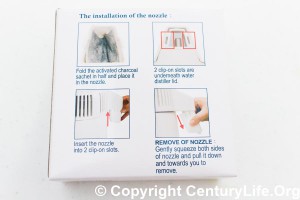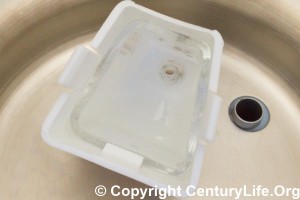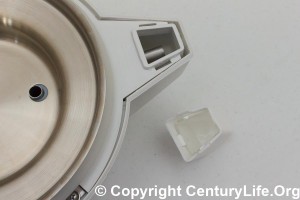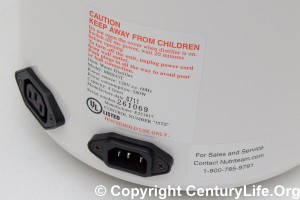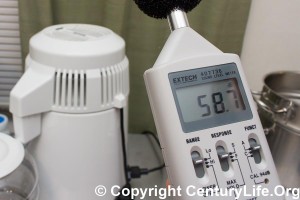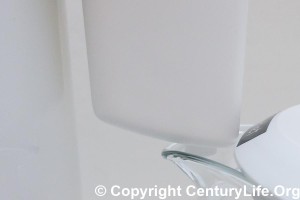
As the New York Times puts it, “Experts now say that no amount of lead in the blood is safe, and that even low levels of exposure can harm cognitive function and have other adverse effects.”1
The effects of lead are irreversible. Lead bioaccumulates–meaning it does not get flushed out with urine or feces. Instead, lead embeds itself in your bones, brain, kidneys, and other organs and causes lots of problems: muscle pain, nausea, diarrhea, vomiting, fatigue, headaches, insomnia, anemia, behavior disorders, visual impairment, numbness, abdominal pain, depression, and.. well you get the idea. Even tiny amounts of lead decrease IQ and increase behavioral problems in kids, and adults aren’t immune either.2 For example, an increase in blood lead from 10 to 20 micrograms/dl = a decrease of 2.6 IQ points in school-aged children regardless of whether they were in poor, middle, or upper-class households.3 A decrease of IQ points means worse performance at school/work and lower lifetime earnings, among other things.
Even though scientists have known that there is no “safe” level of lead exposure since the 1920s, the government has been slow to act. For example, federal law (the Safe Water Drinking Act of 1974, as amended throughout the years) defined “lead free” drinking water pipes to mean “up to 8% lead” from 1974 to 2011. After 2011, “lead free” meant “up to 0.25% lead.”4 (On what planet should “lead free” mean “up to 8% lead”? Would you drink “urine free” water that was 8% urine?) For pre-1974 homes, lead limits varied; some local governments were still allowing 100% lead pipes. On a related note, lead paint for residential construction was not banned until 1978, and gasoline-makers were legally adding lead to gas until 1986.5
Flint is famous for failing to keep lead out of its drinking water, but in December 2016, Reuters found nearly 3,000 areas with recently recorded lead poisoning rates at least double those in Flint during the peak of that city’s contamination crisis. And more than 1,100 of these communities had a rate of elevated blood tests at least four times higher.6 More than 5,000 water systems across the country are violating rules meant to keep lead out of drinking water.7 U.S. water infrastructure has been decaying all over the country for decades: in Sebring, Ohio, the city waited five months to warn pregnant women and children to stop drinking their lead-contaminated water, and Washington D.C. waited three years to warn its residents after lead spiked to as much as 20 times the federally-approved limit.8
Worse, lead is only one of many different toxic substances that can make it into drinking water supplies. The same New York Times article referenced above also talks about how tap water testing can be spotty in terms of geography and in time: in Brick Township, New Jersey, almost no homes exceeded the EPA limit for lead in 2011. Three years later, nearly half of the tested 34 homes exceeded the limit. Affected homeowners drank contaminated water for three years thinking they were safe.
And then there’s this:
The biggest hole in the drinking-water safety net may be the least visible: the potential for water to be tainted by substances that scientists and officials have not even studied, much less regulated.
The E.P.A. has compiled a list of 100 potentially risky chemicals and 12 microbes that are known or expected to be found in public water systems, but are not yet regulated. In the last 15 years, it also has required water systems to test for 80 additional contaminants to see whether they merit regulation.
So far, it has decided to place limits on just one, perchlorate, a salt found in rocket propellants and explosives. And what an arduous decision it has been: The E.P.A. began tests for perchlorate in 2001 and resolved to regulate it in 2011, but does not expect to publish its proposed rule until March 2017.
There are thousands of other chemicals, viruses and microbes that scientists like Dr. Griffiths say the agency has not begun to assess.
…
Toledo, Ohio, shut down its drinking water for three days in 2014 after microcystin, an unregulated toxin produced by algae-like bacteria clogging Lake Erie, tainted its supplies. Microcystin and related toxins, which can cause liver damage and have killed animals, have since been added to the list of potentially dangerous contaminants. [Presumably, at the time the list was created, scientists did not know about, or underestimated, the risk.]
Another example: Many water systems draw from rivers loaded with nitrates, the product of fertilizer runoff and sewage overflow. But researchers were long unaware that removing nitrates from finished water can leave behind a toxic byproduct, nitrosamines, the cancer-causing chemical found in cooked bacon.
The soup of contaminants in many water sources holds other possibilities for trouble. The E.P.A.’s latest list of potentially risky substances includes some variants of estrogen, compounds from birth-control pills and other pharmaceuticals that are already linked to sexual changes in fish. Individually, they probably pose little risk to humans. Together, Dr. Klaper said, the risk may or may not be greater.
“Well okay,” you might think. “Tap water can be problematic, but I’m protected by my Brita water filter (or similar filters such as PUR filters
).
But those are incomplete solutions:
- First, these filters use activated carbon (carbon, such as charcoal, that has been heated or otherwise treated to increase its ability to attract contaminants) to filter out damaging chemicals and metals, but the filters lose efficiency with use, which is why you’re supposed to replace them periodically (Brita and PUR recommend every 2 months or 40 gallons, whichever comes first). If you have especially high amounts of contaminants in your water, you may have to change your filter a lot more often.
- Even at peak efficiency, these filters still let some stuff through. Brita keeps changing its filter specs so it’s hard to nail them down to a number, but as of 2016 they were still letting ~0.7% of lead through.9 And that’s with brand new filters. It’s unclear what their filters let through after, say, 20 gallons, after which the filter is no longer at peak efficiency.
- Brita recently began to recycle filters, and if not recycled, those filters take up space in landfills.10
- Lastly, even if you live in a good water district, if your neighborhood or home has older pipes, you may be getting contamination from those pipes. You could have your water tested, but you’d have to do it periodically because things can change quickly without your realizing it, such as in Brick Township, New Jersey (above).
The bottom line is that you should not rely too much on the government or Brita-style water filter pitchers to provide safe drinking water.
The good news is that you can take matters into your own hands. You don’t need thousand-dollar water reverse-osmosis units with expensive filters or anything like that. Below, I’m going to show you how you can purify water at far lower cost.

CHEAP WATER PURIFICATION:
So how do I turn tap water into cheap, purified water? Water distillation!
I’ve been meaning to review my water distiller for a long time now; I bought it in 2011. The recent stories about lead-contaminated tap water in Flint, Michigan pushed me to finally do this review, because a lot of people seem to think you need to spend a lot of money for clean water, and that isn’t true. These are all the steps to distilling water:
First, as a completely optional, skippable step, I run room-temperature tap water through a Brita water filter pitcher. (You could also use PUR filters
but those tend to be more expensive.) Brita filters don’t cost much–about $7 each, or a little less if you buy in bulk. The so-called “activated” (heat-treated) carbon inside of the Brita filters pulls contaminants out of the water that flows through the filter. However, using hot water with activated carbon filters decreases the filter’s efficiency, so for best results, use cold water.
Second, I pour the water into my Megahome Countertop Water Distiller and let the distiller do the rest. (The distiller has its own slot for a carbon filter, so you can either carbon-filter with the Brita or with the distiller’s carbon filter. You don’t need both.)
That’s it! Easy.

HOW DOES WATER DISTILLATION WORK?
The basic idea behind residential water distillation is to boil tap water and let the water vapor rise into cooling pipes, where the water vapor condenses back into liquid water and drips down and out into a waiting container such as a glass jar. Since contaminants like heavy metals don’t boil at 212F (100C), those contaminants get left behind inside the water distiller.
There is a wrinkle to this idea: some other chemicals (e.g., volatile organic compounds) vaporize at 212F/100C or lower, so they follow the water vapor into the condensing pipes. Your Brita filter should get rid of most of those chemicals, but if you want to filter your water after it’s boiled instead of before, use activated carbon filters in your distiller–yes, the same activated carbon/charcoal that is inside Brita water filters. Six packs are included with the Megahome countertop water distiller to get you started. You just slide them into the nozzle so that water drips through the carbon before dripping down into the water collection jar.
Many people have Brita or PUR water filters are home already, so I’m going to devote the rest of this entry to a review of the Megahome Countertop Water Distiller itself.

THE GOOD:
I’ve had the Megahome Countertop Water Distiller since 2011 and it’s given me no problems and lots of distilled water. These units withstand a lot of use.
Some highlights of this product:
- This countertop water distiller is the cheapest one where a) the manufacturer has a very long track record for support and warranty service, and b) the product is UL (Underwriters Laboratories)-approved. UL tests and certifies equipment safety, oftentimes abusing equipment to the point of destruction. If a product isn’t UL-listed, that’s a red flag that it may not be safe. It’s not worth burning down your home to save a few bucks on a device like a water distiller which you may leave unsupervised for hours at a time. In any case, this unit is made in Taiwan, which is industrialized and tends to have better manufacturing standards than China.
- Automatic shutoff when the temperature of the distiller’s bottom goes above boiling.
- Baked-on minerals are harder to clean, and some people don’t like how mineral deposits get baked on if you let the unit automatically shut off due to temperature. So they use timers to stop the distiller before it boils completely dry. There are very few 3-prong socket timers with the ability to automatically shut off after an arbitrary amount of time (rather than a preset amount of time like 4 hours), which is why the Century Mechanical Countdown Timer with Grounded Pin – Energy Saving
is popular.
- Baked-on minerals are harder to clean, and some people don’t like how mineral deposits get baked on if you let the unit automatically shut off due to temperature. So they use timers to stop the distiller before it boils completely dry. There are very few 3-prong socket timers with the ability to automatically shut off after an arbitrary amount of time (rather than a preset amount of time like 4 hours), which is why the Century Mechanical Countdown Timer with Grounded Pin – Energy Saving
- Water never touches anything other than stainless steel or glass, and if you see reviews stating otherwise, they are for older models made prior to 2011. (Specifically, you pour the water into a stainless vessel inside of the distiller, the water vapor goes into stainless pipes, and the water comes out of a glass-lined spigot. Stainless steel and glass will not impart toxic chemicals into the water.)
- The unit won’t easily slide around on a countertop. The unit weighs about 8 pounds empty and 16 pounds when filled with a gallon of water, plus it has three rubber feet.
- The unit stands 14.5 inches tall so it will fit beneath kitchen cupboards (which usually have 18 inches of clearance).
- The bottom of the nozzle actually protrudes ever so slightly into the lip of the glass jar, to ensure drip-free distillation.
- There is space in the distiller’s nozzle to use activated carbon filters
to absorb chemicals that get vaporized along with the water. (Boiling water leaves heavier things like metals behind but not lighter chemicals that can vaporize along with water.) If you already used a Brita to filter out most those volatile organic compounds, then it’s not strictly necessary to use activated carbon filters in your distiller, too, but it doesn’t cost much extra. If you want to save money, then skip the Brita and just use carbon filters in the distiller.
- If you’re wondering why a small pouch of charcoal at the tip of the water distiller lasts almost as long as a much-larger Brita (30 gallons vs. 40 gallons), it’s because the Brita is filtering raw tap water that contains metals AND volatile organic compounds, whereas the little pouch of charcoal is filtering ONLY volatile organic compounds–the stuff that turns into gas along with water vapor and thus tags along with the water vapor all the way to the nozzle tip. So the pouch has a much easier job.
- If you use the water distiller with its small pouches of charcoal in the distiller’s nozzle, then your costs for purified water are $0.40/gallon + $0.65 in non-electricity costs per month, or $0.44/gallon, or about $7/month/person. If you use Brita filters instead of the nozzle-tip pouches, then you pay $0.60 cents/gallon, or about $9/month/person, depending on how often you change your Brita filters. (Brita recommends changing them every 40 gallons or 2 months, whichever comes first.)
- Here’s the math: an adult uses about 1 gallon of cooking/drinking water per day, or 30 gallons per month. However, some of that water comes from outside of the home, such as at work, or at restaurants either directly in glasses of water or indirectly via water used to cook your restaurant orders. You might also order take-out or drink water in the form of juice, milk, etc. Thus an adult might consume more like 15 gallons of water per month at home for drinking/cooking. How much does it cost to double-filter+distill 15 gallons per month?
- It takes ~5.5 hours to completely distill a gallon of room-temperature water. At 580 watts (the product specs, though my unit uses about 565 watts), the distiller uses 0.580 x 5.5 = 3.19 kWh. The forecasted average residential electricity rate in the U.S. for 2016 is 12.65 cents. 3.19 x $0.1265 = $0.4035. So it costs 40 cents’ worth of electricity to distill a gallon of tap water, or $6/month. The distiller’s activated charcoal filter lasts 30 gallons according to manufacturer specs, plus there are the small costs of residue cleaning and flavoring (if necessary), and the nearly negligible costs of the water itself. Thus the cost to filter 15 gallons (one person’s monthly needs) is $0.4035 x 15 + half of a $1.25 filter = $6.68 + some minor residue cleanup and flavoring costs so we’ll round up to $7. Comparing store-bought water at $1/gallon (which comes in plastic!) vs. buying and running a distiller for a family of four, it breaks down to $720/year for bottled water vs. $336/year for the distiller.
- It’s a little more expensive if you use Brita filters instead of nozzle-tip filters. Brita filters cost about $6.50 each and last for 40 gallons according to manufacturer specs11, so it costs about $2.44 to filter 15 gallons of water (15 divided by 40, times $6.50). So the cost to filter 15 gallons is $0.4035 x 15 + $2.44 = $8.49 + some minor residue/flavoring costs, so we’ll round up to $9. Comparing store-bought water at $1/gallon (which comes in plastic!) vs. buying and running a distiller for a family of four, it breaks down to $720/year for bottled water vs. $432/year for the distiller. That’s a substantial savings even if you use Brita filters, which are pricier than distiller nozzle-tip carbon pouches.
THE BAD:
- It takes 5-6 hours to produce one gallon of distilled water, depending on the temperature of the tap water, hence why the distiller is rated for only up to 4 gallons of distilled water per day (it can barely produce 4 gallons of water per day if you ran it 24 hours per day).
- This may sound slow, but it can be enough for a household of up to four people depending on how much you drink and if you can start the distiller during sleep or work hours so that it’s finished by the time you wake up or come back home from work. For example, start the distiller a little before bedtime and you’ll have a gallon ready to go in the morning.
- If you heat the water to lukewarm temperatures before putting it into the water distiller, that can shave off an hour of distillation time.
- The unit’s fan produces a whir for the duration of the distillation process. It’s not that loud, but it’s there. At about 12 inches away we measured the decibels as less than 60 dBA, or about the same loudness as a semi-quiet conversation at home. In other words you’ll notice it when you’re in the same room, but it’s rather muffled if you are one room away, and you can barely hear it through a door.
- The unit produces exhaust heat into your home, which is a minus during hot summers, though it’s a plus during cold winters.
- Some people have trouble removing the glass-lined nozzle after it is attached via the two plastic clip-ons. Instead of using your fingers, use a flat-headed screwdriver at the very base (where the nozzle connects with the distiller top), and release one side at a time. You may need to take a nail file and file down the notches if you still have problems removing the nozzle. Whatever you do, don’t squeeze too hard or you will break the glass that lines the bottom 2/3 of the nozzle. Apparently enough people do that so that Megahome included a backup nozzle in my box.
- Distilled water is warm, which some people dislike. This problem can be lessened by letting the water cool down to room temperature or by putting the jar in the fridge. You can also simply plop ice cubes into the distilled water and the melted ice cube should cool things down significantly.
- Some people don’t like the taste of distilled water because they’re used to the taste of less-pure water. Also, distilled water lacks impurities like calcium, magnesium, sodium, and fluoride which are good for your body.
- This is not a real problem because if you are eating well then you will get plenty of calcium and magnesium from food, rather than from drinking water. For example, a single green smoothie or multivitamin each morning will give your body plenty of calcium/magnesium/etc. As for sodium, most people get too much salt in their diet anyway.
- If you want to remineralize your water anyway, there are a few cheap ways to do so. One way is to sprinkle a bit of finely ground Himalayan sea salt
into the water. Another way is to use a pre-made mixture like ConcenTrace Trace Mineral Drops
or Andersons Sea M.D. Concentrated Mineral Drops
. Himalayan sea salt is the cheapest of those methods, and you can also use it like regular salt to cook with. But if you’re cooking with it as well as using it for water distillation, you probably want to get a larger amount, like a five-pound bag
, which costs a little less per pound than smaller bags. Beware that there are some Himalayan sea salt forgeries floating around, so only buy Himalayan sea salt from reputable brands. Also, remember that you can always add more flavor but it’s hard to take the flavor back out. With these salts and minerals, a little goes a long way so try using just a pinch or a drop and seeing if that works for you.
- As for fluoride, which helps repair/prevent tooth decay by physically bonding to your teeth, drinking tap water (which has fluoride added to it) is an inefficient way to get fluoride onto your teeth. If fluoride is an issue to you, then you could simply use toothpaste
, brush-on gel
, or mouthwash
that has fluoride inside, and apply those directly to the teeth.

THE UGLY:
- Tap water often contains minerals which are left behind during boiling. Over time, these mineral deposits become visible and unsightly messes that you should clean every couple of months with a descaler like Megahome Distiller Residue Cleaner (made from citric acid)
or Water Distiller Residue Cleaner (also made from citric acid)
. You may also use BKF which works decently well, or ordinary vinegar which in my experience works less well but is cheap and readily available. (If you have some wine that’s gone bad and is thus turning into vinegar, just pour it into your distiller and let it sit for half an hour before rinsing and scrubbing.)
- The pot/jug/bottle that comes with the distiller is made out of thin glass. You have to assemble it by wrapping the included metallic straps around the jug and attaching a handle. It works, but the glass is thin. Still, it’s surprisingly hard to find a one-gallon jug made out of glass, so I would get the Megahome water distiller that comes with the glass jar unless you absolutely know you won’t need it. (Plastic can leach chemicals into warm water, such as the warm water that comes out of a water distiller, so gallon plastic containers aren’t ideal.)
- If you want something more rugged, you could use a stainless steel stock pot (with a lid slightly ajar, to act as a dust cover yet leaving enough room for water to trickle into the pot). Alternatively, you can use an glass, enamel or ceramic container if you don’t have a good-quality stainless steel pot.
- If you absolutely know that you won’t have any use for the Megahome glass jar, then get the version of the Megahome Water Distiller that comes with a plastic jar
which is normally a bad buy because warm, distilled water leaches chemicals out of plastic. Since you’re going to use your own stainless or glass/enamel/ceramic pot anyway, you can get rid of the plastic jar that comes with the unit an save a little money over the versions of the water distiller that come with glass pots. But only do this if you know for a fact you won’t need the glass jar, because it can be very hard to find gallon-sized glass jars.

CONCLUSION:
- If you thought purifying water was expensive, consider the enormous cost over one’s lifetime of NOT purifying your water. Lead alone can cause dozens of problems, like muscle pain, nausea, diarrhea, vomiting, fatigue, headaches, insomnia, anemia, behavior disorders, visual impairment, numbness, abdominal pain, depression, and lower IQ. Lead is nasty stuff that accumulates in your body. Once lead burrows its way into your bones, brain, kidneys, and other organs, it’s really hard to get it out of your body. The solution is to avoid eating or drinking lead in the first place. And lead is just one of many other tap water contaminants
- Buying expensive reverse osmosis or other such systems can cost thousands of dollars. Buying bottled water at $1+/gallon is also expensive in the long run, plus that water typically comes in plastic bottles which can leach chemicals into the water. But using a countertop water distiller costs only ~44 cents/gallon to make your own filtered, distilled water which is far superior to tap water or even the water from a Brita water filter (or similar filters such as PUR
filters
). You can still use a Brita to filter tap water and then feed that filtered water to your distiller to make double-filtered, extra-extra-pure water, for ~$0.60 per gallon. But it’s cheaper to just use activated carbon/charcoal filters in your distiller nozzle.
- The Megahome water distiller is the cheapest one that’s got Underwriters Laboratories (UL) certification so it won’t burn your house down, and it’s well-built and will last a very long time. (Avoid similar-looking Chinese water distillers which aren’t UL-certified. Megahome water distillers are made in Taiwan.)
- The Megahome countertop water distiller comes in three styles: stainless exterior with black accents
, stainless exterior with white accents
, and white enamel exterior
. All of them have the same internals, and water never touches plastic in any of those models. The only difference is the exterior. (I don’t think it’s worth the extra money for a stainless steel finish instead of a plain white enamel finish, but if it’s worth it to you, go for it.) All of them come with glass water-collection jars.
- Megahome also carries a cheaper countertop distiller product line that use plastic jars instead of glass jars. Gallon-sized glass jars are very hard to find, but if you know you don’t want the glass jar then get the water distiller that comes with a plastic jar to save a little money. The plastic-jar bundles are available in stainless exterior with black accents
and white enamel exterior
. Plastic leaches chemicals into water (especially warm water like what comes out of a distiller), so don’t use the plastic jar. Instead, use your own stainless steel, ceramic, glass, or enamel pot. The pot should be well-built to make it relatively kid/pet-proof. If it’s a stainless pot, make sure it’s 18/8 (304) stainless or better to avoid corrosion/rust issues. (The stainless should be of sufficient quality if an ordinary kitchen magnet will not strongly stick to the side of the pot.) The bottom of the nozzle is about 7.5 inches from the bottom of the unit, but that doesn’t mean you must use a pot that is 7.5 inches tall. You can simply slide a book or two underneath the water distiller to accommodate taller pots. An example of a container you could use is the Update International (SPS-8) 8 Qt Induction Ready Stainless Steel Stock Pot w/Cover
which is about 7 inches tall and has a cover you can leave slightly ajar to accept water but to prevent most dust from entering the pot, though it’s harder to pour small amounts of water out of due to its large diameter. Also, I would recommend using a partially-ajar lid or plastic wrap
or aluminum foil
to block dust from falling into the water. If you ever decide that you want a Megahome glass jar instead of using your own pot, you can separately buy the Megahome glass jar (black) (also available with white accent
).
- No matter which water distiller bundle you get, in the box you should get a few packs of activated charcoal filters and a small amount of residue cleaner to get you started for several months until you buy replacement activated carbon/charcoal filters and Megahome Distiller Residue Cleaner (made from citric acid)
to get rid of mineral buildup in your distiller. (Alternatively, use BKF or vinegar to clean, though vinegar does not clean quite as well.) According to the manufacturer, you’re supposed to change the filter every 30 gallons, so a 2 person household might need only 1 filter change per month, but a 4 person household might need biweekly changes depending on how much distilled water the household consumes.
- Baked-on minerals are harder to clean, and some people don’t like how mineral deposits get baked on if you let the unit automatically shut off due to temperature. So they use timers to stop the distiller before it boils completely dry. There are very few 3-prong socket timers with the ability to automatically shut off after an arbitrary amount of time (rather than a preset amount of time like 4 hours), which is why the Century Mechanical Countdown Timer with Grounded Pin – Energy Saving
is so popular.
Brita and PUR pitchers and filters:
Megahome Water Distillers with Glass Jars:
Megahome Water Distillers with Plastic Jars:
Activated Carbon (Charcoal) Filters and Residue Cleaners:
Mineral Packs (for taste):
Timer, Spare Glass Jars, and an example of stainless steel stock pot that works to collect water if you don’t want to use glass jars (7 inches tall; the distiller nozzle’s bottom is 7.5 inches tall):
